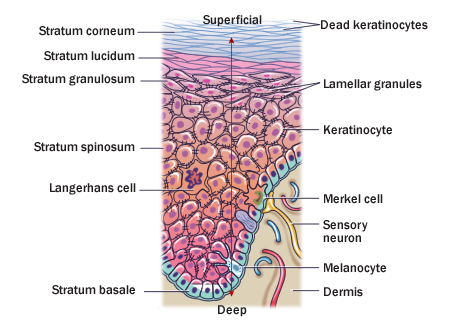The Epidermis
Objectives:
- Identify the functions of the epidermis.
- Identify the cells forming the epidermis and their function.
- Understand the function of melanin.
- Understand the structure and characteristics of the epidermal layers found in thick and thin skin.
Mouse over each label to view definition

Epidermis
The epidermis is the superficial layer of the skin and consists of stratified squamous epithelium that is keratinized (containing the protein keratin). It forms the tough outer covering of our body allowing us to withstand physical, chemical, and thermal insults. Because the epidermis is avascular, it relies on the underlying dermis for nutrient and gas exchange.
Cells
There are four basic cells forming the epidermis:
- Keratinocytes
- Melanocytes
- Dendritic (Langerhans) cells
- Tactile (Merkel) cells
Layers
The epidermis is composed of five layers in thick skin, the skin located at the soles of the feet and palms of the hands.
The layers include:
The epidermis is composed of five layers in thick skin, the skin located at the soles of the feet and palms of the hands.
The layers include:
- stratum corneum,
- stratum lucidum
- stratum granulosum
- stratum spinosum
- stratum basale.
The skin located throughout the rest of the body is categorized as thin skin. It lacks the stratum lucidum seen in thick skin.